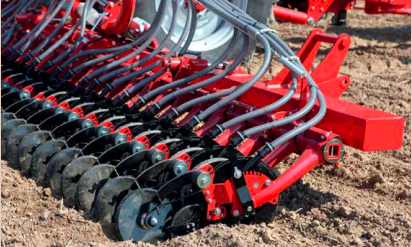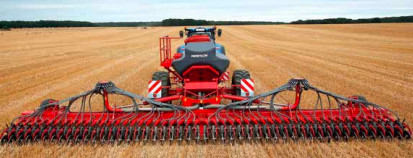
Staff changes and opting for a bigger drill
Someone once told me that one of the great skills of good management was not being afraid to change your mind. Over the last decade our move to conservation agriculture has created the need to change machinery and labour profiles to match the workload and give us the balanced and efficient fixed cost structure necessary for profitable, subsidy free, combinable crop production. This transition has been gradual. I know when some make fundamental changes to their farming system a farm sale is the first step, often followed by redundancies for staff no longer required. We chose to approach things differently, rapid changes can be expensive, machines sold before their previously budgeted lifespan can look expensive and no one ever wants to have to let good, loyal and skilled staff go. For us the initial transition was simple as our drilling had been done by a contractor for whom in return, we applied inputs and harvested his crops. Ending that agreement and buying a used 750a and a Dale drill to take this work back in house was all that was required. We were fortunate enough to take on an additional contract farm at that time, so no labour had to be let go, the same men were simply able to cope with a greater workload spreading their fixed costs more efficiently.
Over following years changes to the machinery we ran were made gradually, as tractors needed changing their replacements were much more suitable smaller models, that initial 4m second-hand 750a was replaced by a higher output 6m model and the Dale replaced by a much cheaper Horsch C06 conversion. Every change was very carefully considered and only done when a good reason was present. Rising new machinery prices and increasing demand for the equipment we were selling made things relatively painless, the business grew as more contract farming opportunities presented themselves, yet with the much-simplified farming system in place existing labour was able to cope comfortably.

The move away from a self-propelled sprayer to trailed that I wrote about in the last issue of Direct Driller was the final piece of a jigsaw that had taken just over 10 years to complete and I felt we had everything pretty much as efficient as I could get. The wallet was firmly closed, and I felt really rather smug that, come what may through Brexit or changes to farm subs, we were well set up to cope and had nothing but fine details to change over the coming years.
Then, as is so often the case in life, a curved ball gets thrown……. we run a small team of just 3 full time employees; I have always been extremely lucky to employ and work with some exceptional people. I have known two of them since we were in short trousers and was honoured to be best man at both of their weddings. They are not employees, they are some of my closest and best friends. I try to understand their needs, pay them as well as is affordable and involve them in every decision we take. I think as farm jobs go they do alright, we pay a salary well in excess of national farm wages, provide a very nice house for some and are flexible re time off, only really working weekends at harvest and drilling time. The equipment, buildings and facilities are all modem and well maintained and generally we let them manage their own time. It’s a team game, no one works for me, they all work WITH me.
So imagine the surprise when Mark, my friend and longest standing employee of 29 years, who stated working here at 16yrs old came to us one February morning and announced he was leaving. The reason was not pay, hours or unhappiness, he was in fact moving to much lower paid, shift work position in the elderly care industry. His reason was that of work / life balance, a need to know more certainly when he would be at home and ability to plan holidays and days out in the summer when children were off school. Naturally we all questioned his thinking, I honestly feel what we offer is a pretty good package and we are flexible to try and accommodate opportunity and time to do whatever they wish, but ultimately the decision was not mine to make and shortly after this bombshell announcement he left.
Instantly thoughts moved to replacing him, I advertised the position on The Farming Forum and across social media and had a lot of response very quickly. We often hear that there is a shortage of people wanting to work in agriculture, but this certainly didn’t seem to be the case judging by the response I had.
The filtering of CV’s began, most lacked the experience we needed but a few stood out as the kind of people we wanted to work with. Interviewing these applicants it soon became apparent that they were interviewing us, and all of them seemed to view a move to a “small” tractor and trailed sprayer as a backward step from their current positions where it seems a Quadtrac and a quarter million £ self-propelled sprayer is the badge of honour that singles you out amongst your peers as a “top dog” tractor driver. Quickly I realised that a negative attitude towards no-till farming that I had become all too familiar with amongst other farmers was ingrained much deeper within our industry. All that sexy marketing of big flagship kit that has drawn so many farmers into an unsustainable fixed cost Armageddon had clearly also reached deep into the very core of farming, the skilled men on the seats that make it all happen.
No one we spoke to impressed us, in a small team everyone has to “fit” and try as we might we just couldn’t find that person. Hindsight is a wonderful thing, but we should probably have been training up an apprentice, indeed we did try a couple of years ago, but the usual issues of mobile phone addiction and unreliability saw us give up on that idea quite quickly. We needed a plan ‘B’ and with spring work looming we needed that fast.
The question was could we manage without replacing that man? what would the saving be and what would the extra costs be? A week of burying myself deep in spreadsheets and costings began, it was easy to see the £40,000 a year salary saving that employing one less man would bring along with the capital and depreciation costs of a tractor for him to drive, but could we cope with the workload?
The answer was no, it would simply push remaining staff too far to be sustainable and fall apart in a difficult season. Doing less is a bit of an alien concept to us, our aim has always been to grow the business as viable opportunities presented themselves but a detailed analysis of fixed costs structure with one less full-time employee and frontline tractor consistently led me to better numbers with some of our less efficient contracting work dropped. As luck and life often seems to bring, this all coincided rather neatly with a change of business management for one of our contract farming customers, we were simply not comfortable with the changes and lack of commitment from the new management so gut feeling seemed to back-up the numbers on the spreadsheets and the decision was made. Maybe just like in the principles of our farming system less could be more?
The next consideration was the spread of the remaining workload, the labour gap was primarily for a sprayer driver and that created very little overlap to harvest capacity, it was drilling where the potential conflicts lay with still a very significant area to establish in autumn and spring. The existing 6m 750a and Horsch 6m CO with a ULD conversion had given us 12m of drilling capacity and flexibility between disc and tine but with one less highly skilled operator it would be a lot less likely that we could always be in a position to run both at the same time when required.

If any single machine I have ever owned represents the change to our farm over the years it has to be the John Deere 750a. From the first time we established a crop into tall cover it was clear to us all that it was the key component of a very different way of farming. Our first 750a was bought used from Simon Chiles following a visit to his heavy clay farm, I recall my father saying in the car on the way home from Kent that if he could make it work on his heavy clay soils then it should be a doddle for us on boys land …… and he was right, we never looked back, the 4m being replaced with a 6m in 2015. It’s always been the default choice of the low disturbance disc drills for me but being honest that choice was until quite recent years rather limited in the UK. They are not without limitation, our drill being heavily modified and adapted to make results more consistent, and they are also a drill that needs good and regular maintenance from a switched on and committed operator.
When moving from 4m to 6m I looked no further than the 750a, why change a recipe that we knew worked well? Despite there being a lot more choice in the market these days, I suspect that had a wider 750a been available in the UK, then it would certainly have been top of our list of replacements. But alas 6m is thw widest 750A available.
I wanted to move to at least 8m but ideally 12m to fit with our 12/36 controlled traffic farming system and give us more than enough capacity for even the most difficult of seasons, but I really didn’t want to abandon one of the basic principles of my system which was sticking to lighter lower horsepower tractors. Looking around again it became apparent that not many 12m no-till drills existed especially disc coulter versions which I wanted to stick with to compliment the tine option we have with the ULD CO conversion which we will continue to run. Choice narrowed to the Sly Boss drill and the Horsch Avatar.
The Avatar quickly became the stand out choice for me, at the time the 12m Sly was still not a tried and tested formula in the UK but there were already a couple of 12m Avatar users in the UK which I visited. All I spoke to seemed happy with performance and most impressive of all this drill seemed to have an unbelievably low power requirement for its width with just 230hp recommended by Horsch, meaning we could stick to using our existing Fendt 724 tractors that we use for all other arable operations. The coulter is also very similar to the 750a which gives me confidence as we know that it is a design that works for our soil, row width is however much wider at 25cm and is a big reason I guess for the lower power requirement.
The same as the CO and less than a Vaderstad Seed Hawk demo we had many years ago, which to this day still holds the farm wheat yield record meaning I’m not really concerned that it is a negative, it may in fact prove to be a positive with ideas and plans already in place to trial interrow mowed organic spring milling wheat in the future……….. Watch this space! The final deal clinching detail was the price and standard specification, the 12m Avatar comes with 3 hoppers – ISO, seed, and fertiliser placement, guttler style closing wheels and row cleaners from the factory, all things we had to expensively engineer or add ourselves to the 750a’s and all at a price about 25% cheaper per metre as well.
Time will tell of course but it feels like the right decision, we have more capacity, a new drill, one less tractor to fund and one fewer full-time employee to pay. Of course, we also have a slightly lower gross output, but the spreadsheets tell a tale of the savings more than outweighing those losses. So it seems true what I was told years ago, good management is having the ability to change your mind sometimes, no matter how well you feel you might have things set up there is rarely no room for improvement and sometimes things that may initially feel like a step backwards are actually a step forwards.
